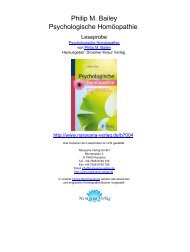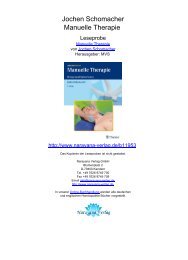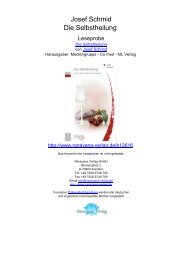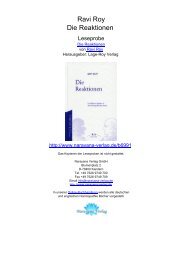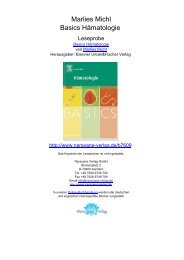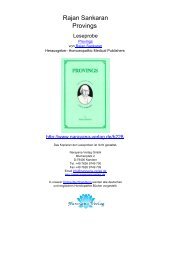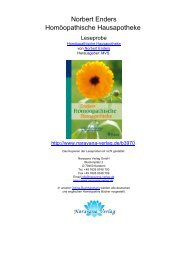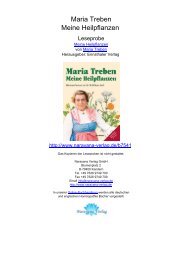Frans Kusse Homeopathic Types
Frans Kusse Homeopathic Types
Frans Kusse Homeopathic Types
Create successful ePaper yourself
Turn your PDF publications into a flip-book with our unique Google optimized e-Paper software.
<strong>Frans</strong> <strong>Kusse</strong><br />
<strong>Homeopathic</strong> <strong>Types</strong><br />
Leseprobe<br />
<strong>Homeopathic</strong> <strong>Types</strong><br />
von <strong>Frans</strong> <strong>Kusse</strong><br />
Herausgeber: Narayana Verlag<br />
http://www.narayana-verlag.de/b8239<br />
Copyright:<br />
Narayana Verlag GmbH<br />
Blumenplatz 2<br />
D-79400 Kandern<br />
Tel. +49 7626 9749 700<br />
Fax +49 7626 9749 709<br />
Email info@narayana-verlag.de<br />
http://www.narayana-verlag.de<br />
In unserer Online-Buchhandlung werden alle deutschen<br />
und englischen Homöopathie Bücher vorgestellt.<br />
Narayana Verlag ist ein Verlag für Homöopathie Bücher. Wir publizieren Werke von hochkarätigen innovativen Autoren wie Rosina<br />
Sonnenschmidt, Rajan Sankaran, George Vithoulkas, Douglas M. Borland, Jan Scholten, <strong>Frans</strong> <strong>Kusse</strong>, Massimo Mangialavori, Kate<br />
Birch, Vaikunthanath Das Kaviraj, Sandra Perko, Ulrich Welte, Patricia Le Roux, Samuel Hahnemann, Mohinder Singh Jus, Dinesh<br />
Chauhan.<br />
Narayana Verlag veranstaltet Homöopathie Seminare. Weltweit bekannte Referenten wie Rosina Sonnenschmidt, Massimo Mangialavori,<br />
Jan Scholten, Rajan Sankaran und Louis Klein begeistern bis zu 300 Teilnehmer.
4<br />
Contents<br />
Foreword � � � � � � � � � � � � � � � � � � � � � � � � � � � � � � � � � 7<br />
What is Homeopathy? � � � � � � � � � � � � � � � � � � � � � � � � � � 9<br />
Introduction to <strong>Homeopathic</strong> <strong>Types</strong> � � � � � � � � � � � � � � � � � � � �10<br />
Aconitum napellus � � � � � � � � � � � � � � � � � � � � � � � � � � � �13<br />
Agaricus muscarius � � � � � � � � � � � � � � � � � � � � � � � � � � � �17<br />
Alumina � � � � � � � � � � � � � � � � � � � � � � � � � � � � � � � � �21<br />
Antimonium crudum � � � � � � � � � � � � � � � � � � � � � � � � � � �25<br />
Apis mellifica � � � � � � � � � � � � � � � � � � � � � � � � � � � � � � �29<br />
Argentum metallicum � � � � � � � � � � � � � � � � � � � � � � � � � � �32<br />
Argentum nitricum � � � � � � � � � � � � � � � � � � � � � � � � � � � �36<br />
Arnica montana� � � � � � � � � � � � � � � � � � � � � � � � � � � � � �40<br />
Arsenicum album � � � � � � � � � � � � � � � � � � � � � � � � � � � � �45<br />
Aurum metallicum � � � � � � � � � � � � � � � � � � � � � � � � � � � �49<br />
Baryta carbonica � � � � � � � � � � � � � � � � � � � � � � � � � � � � �53<br />
Belladonna � � � � � � � � � � � � � � � � � � � � � � � � � � � � � � � �56<br />
Borax veneta � � � � � � � � � � � � � � � � � � � � � � � � � � � � � � �60<br />
Bryonia alba � � � � � � � � � � � � � � � � � � � � � � � � � � � � � � �65<br />
Calcarea carbonica � � � � � � � � � � � � � � � � � � � � � � � � � � � �68<br />
Calcarea phosphorica� � � � � � � � � � � � � � � � � � � � � � � � � � �72<br />
Cannabis indica� � � � � � � � � � � � � � � � � � � � � � � � � � � � � �76<br />
Cantharis vesicatoria � � � � � � � � � � � � � � � � � � � � � � � � � � �80<br />
Carbo vegetabilis � � � � � � � � � � � � � � � � � � � � � � � � � � � � �84<br />
Carcinosinum � � � � � � � � � � � � � � � � � � � � � � � � � � � � � � �89<br />
Causticum � � � � � � � � � � � � � � � � � � � � � � � � � � � � � � � �92<br />
Chamomilla� � � � � � � � � � � � � � � � � � � � � � � � � � � � � � � �95<br />
Cuprum metallicum� � � � � � � � � � � � � � � � � � � � � � � � � � � �98<br />
Cyclamen europaeum � � � � � � � � � � � � � � � � � � � � � � � � � � 101<br />
Dulcamara � � � � � � � � � � � � � � � � � � � � � � � � � � � � � � � 104<br />
Ferrum metallicum � � � � � � � � � � � � � � � � � � � � � � � � � � � 107<br />
Ferrum phosphoricum� � � � � � � � � � � � � � � � � � � � � � � � � � 111<br />
<strong>Kusse</strong>: <strong>Homeopathic</strong> <strong>Types</strong> Copyright Narayana Verlag www.narayana-verlag.de
Gelsemium sempervirens � � � � � � � � � � � � � � � � � � � � � � � � 114<br />
Graphites � � � � � � � � � � � � � � � � � � � � � � � � � � � � � � � � 117<br />
Hepar sulfuris � � � � � � � � � � � � � � � � � � � � � � � � � � � � � 121<br />
Hyoscyamus niger � � � � � � � � � � � � � � � � � � � � � � � � � � � � 124<br />
Ignatia amara � � � � � � � � � � � � � � � � � � � � � � � � � � � � � � 128<br />
Kali bichromicum � � � � � � � � � � � � � � � � � � � � � � � � � � � � 132<br />
Kali carbonicum� � � � � � � � � � � � � � � � � � � � � � � � � � � � � 135<br />
Lac delphinum � � � � � � � � � � � � � � � � � � � � � � � � � � � � � 139<br />
Lachesis muta� � � � � � � � � � � � � � � � � � � � � � � � � � � � � � 141<br />
Ledum palustre � � � � � � � � � � � � � � � � � � � � � � � � � � � � � 146<br />
Lithium metallicum � � � � � � � � � � � � � � � � � � � � � � � � � � � 149<br />
Lycopodium clavatum � � � � � � � � � � � � � � � � � � � � � � � � � � 152<br />
Magnesium Compounds� � � � � � � � � � � � � � � � � � � � � � � � � 156<br />
Medorrhinum� � � � � � � � � � � � � � � � � � � � � � � � � � � � � � 160<br />
Mercurius solubilis � � � � � � � � � � � � � � � � � � � � � � � � � � � 164<br />
Natrum carbonicum� � � � � � � � � � � � � � � � � � � � � � � � � � � 168<br />
Natrum muriaticum� � � � � � � � � � � � � � � � � � � � � � � � � � � 171<br />
Nux vomica � � � � � � � � � � � � � � � � � � � � � � � � � � � � � � � 175<br />
Phosphorus � � � � � � � � � � � � � � � � � � � � � � � � � � � � � � � 180<br />
Platinum metallicum � � � � � � � � � � � � � � � � � � � � � � � � � � 185<br />
Pulsatilla pratensis � � � � � � � � � � � � � � � � � � � � � � � � � � � 189<br />
Rhus toxicodendron � � � � � � � � � � � � � � � � � � � � � � � � � � � 193<br />
Ruta graveolens � � � � � � � � � � � � � � � � � � � � � � � � � � � � � 198<br />
Sepia officinalis � � � � � � � � � � � � � � � � � � � � � � � � � � � � � 202<br />
Silicea terra � � � � � � � � � � � � � � � � � � � � � � � � � � � � � � � 207<br />
Staphisagria� � � � � � � � � � � � � � � � � � � � � � � � � � � � � � � 211<br />
Sulfur � � � � � � � � � � � � � � � � � � � � � � � � � � � � � � � � � � 215<br />
Thuja occidentalis� � � � � � � � � � � � � � � � � � � � � � � � � � � � 220<br />
Tuberculinum � � � � � � � � � � � � � � � � � � � � � � � � � � � � � � 226<br />
Index � � � � � � � � � � � � � � � � � � � � � � � � � � � � � � � � � � 230<br />
Acknowledgements � � � � � � � � � � � � � � � � � � � � � � � � � � � 243<br />
<strong>Kusse</strong>: <strong>Homeopathic</strong> <strong>Types</strong> Copyright Narayana Verlag www.narayana-verlag.de<br />
5
Foreword<br />
During the 200-year history of homeopathy, our knowledge of<br />
homeopathic remedies has continually expanded. To begin with,<br />
the focus was on illnesses and symptoms. These are, after all, the<br />
reason why a patient seeks out a doctor. In the course of time,<br />
however, it became clear that there’s more to those symptoms and<br />
illnesses than first meets the eye. Illnesses can turn into other illnesses,<br />
such as when eczema becomes asthma or diarrhea changes<br />
into rheumatism. And it seems that certain types of illness occur<br />
in particular kinds of people. So we found, for example, that the<br />
homeopathic remedy Calcarea carbonica is more often needed by<br />
people who are stocky and who freeze easily, with a preference for<br />
sweet things. These characteristics are summarized in the idea of a<br />
person’s “constitution” or “constitutional type”.<br />
We’ve also discovered additional and deeper aspects of homeopathic<br />
remedies in recent decades.<br />
Vithoulkas described the essence of homeopathic remedies, such as<br />
the outgoing Phosphorus type who easily makes contact with others<br />
and can even feel the suffering of others.<br />
The next step was to ask the question why. Why do people behave<br />
in a particular way? Why is the Phosphorus type so sympathetic?<br />
If we look at it more closely, we see that this behavior conceals a<br />
great fear of being alone in the world. This way of approaching and<br />
observing the problem enables us to understand why people behave<br />
in certain ways and not in others, and what situations in their life<br />
have caused blockages.<br />
<strong>Homeopathic</strong> literature has trailed the developments of recent<br />
decades, since the old books only describe the symptoms and constitution.<br />
<strong>Frans</strong> <strong>Kusse</strong>’s book fills this gap. It contains modern,<br />
up-to-date descriptions of homeopathic remedies. If we study, for<br />
example, Calcarea carbonica, we can find information not only about<br />
the set of complaints these people suffer from but also the underlying<br />
problem. How does a Calcarea carbonica person behave?<br />
<strong>Frans</strong> <strong>Kusse</strong> writes grippingly and with refreshing clarity. He has<br />
always been keen to spread his knowledge of homeopathy widely.<br />
And this is exactly what he has achieved here – after we’ve read<br />
<strong>Kusse</strong>: <strong>Homeopathic</strong> <strong>Types</strong> Copyright Narayana Verlag www.narayana-verlag.de<br />
7
8<br />
Foreword<br />
this work, his portraits will remain engraved in our memory. I can<br />
recommend this book to anyone who is interested in the current<br />
developments in homeopathy.<br />
Jan Scholten<br />
<strong>Kusse</strong>: <strong>Homeopathic</strong> <strong>Types</strong> Copyright Narayana Verlag www.narayana-verlag.de
Origin<br />
220<br />
Thuja occidentalis<br />
Tree of life — Plant remedy (Cupressaceae family)<br />
“Am I allowed to be myself?”<br />
They harden themselves because they feel as if<br />
others can look straight through them.<br />
This remedy is prepared from a tincture of the fresh green twigs<br />
of the western tree of life. A long time ago, it was given the name<br />
tree of life (from the Latin arbor vitae), which says a lot about its<br />
ability to restore our life energy. Originally, the tree of life only grew<br />
in the northern United States and Canada. In the middle of the<br />
18th century, it was imported to France. Due to its naturally perfect<br />
conical shape, it’s used for high hedges. It has a characteristically<br />
thick leaf covering, through which the trunk is not visible.<br />
Vaccination<br />
In the past, Thuja was the homeopathic remedy of choice for<br />
complaints following vaccination. It used to be common to only<br />
vaccinate against smallpox, and since Thuja is one of the main<br />
remedies for skin abscesses, it’s not surprising that Thuja can in many<br />
cases heal the effects of vaccinations. Nowadays, many other vaccines<br />
are in use so that different homeopathic remedies are needed to treat<br />
problems arising from vaccination. There have been good reports of<br />
homeopathically potentized vaccines, such as DPT 200C (DPT is a<br />
combined vaccine against diphtheria, pertussis, and tetanus).<br />
One of Hahnemann’s patients prompted him to come up with the<br />
idea of making a homeopathic remedy from this tree. The patient<br />
was a priest who had all sorts of complaints that Hahnemann was<br />
unable to classify. Like a detective, Hahnemann followed everything<br />
the priest did to try and find the cause of his mysterious symptoms.<br />
Eventually he found the “culprit”! As he wandered around reading<br />
his prayer book, the unhappy priest always passed by a Thuja tree<br />
and absentmindedly plucked a twig. He put this in his mouth and<br />
started chewing it – and this was the source of his problems! As we<br />
<strong>Kusse</strong>: <strong>Homeopathic</strong> <strong>Types</strong> Copyright Narayana Verlag www.narayana-verlag.de
Thuja occidentalis<br />
might expect from homeopathy’s<br />
law that “like cures like”, Thuja also<br />
cured those symptoms.<br />
Sensitive<br />
People who need Thuja are by<br />
nature very sensitive to particular<br />
moods. The impression people<br />
make, the prevailing mood in a<br />
house, or music – absolutely anything<br />
can move them deeply. This<br />
sensitivity means they’re often artistically<br />
gifted, in music as well as in<br />
writing and poetry. As children, they<br />
Thuja occidentalis have paranormal abilities. If those<br />
around them react positively to this,<br />
they can develop in a harmonious way. It’s important for Thuja<br />
people that they’re accepted as they are. Since they are by nature so<br />
sensitive, they’re easily hurt.<br />
Vulnerability<br />
The inner vulnerability of Thuja people is best illustrated by the<br />
feeling of “being made of glass”, although they rarely express it in<br />
this exact way. But in my practice, I had one female patient who<br />
put it in precisely these words, and she reacted marvelously well to<br />
Thuja for many years. The feeling “being made of glass” expresses<br />
how fragile and vulnerable someone is. In addition, glass is<br />
obviously transparent – Thuja people feel as if other people can see<br />
straight through them. When they become unsettled, they can find<br />
it unbearable to be touched or looked at.<br />
The only possibility they see to defend themselves against this<br />
vulnerability is to shut themselves off from those around them. Just<br />
as the tree of life has a thick layer of foliage, they hide behind a<br />
mask or shield. From the outside, they seem thoroughly adapted;<br />
they know exactly what is expected of them because they can sense<br />
this very well. This gives other people the impression that they aren’t<br />
221<br />
<strong>Kusse</strong>: <strong>Homeopathic</strong> <strong>Types</strong> Copyright Narayana Verlag www.narayana-verlag.de
222<br />
Thuja occidentalis<br />
being themselves and are pretending<br />
to be something other than they<br />
really are – as if they were carrying<br />
round a secret inside.<br />
Hardening<br />
Driven by their well-developed<br />
inner survival instinct, Thuja people<br />
tend to harden themselves. Their<br />
original feelings and talents are<br />
thereby transformed into a kind<br />
of fanaticism. Their thinking can<br />
become dogmatic and, for example,<br />
sport can become their main goal<br />
in life and self-realization can turn<br />
into religious asceticism. They want<br />
Thuja occidentalis<br />
nothing more to do with other people and become as stiff as a tree<br />
trunk. They throw themselves into their work with such excessive<br />
zeal that they forget the original point of it all. As with Silicea, the<br />
details become more important than the whole.<br />
This hardening is connected to the desire for control. Through<br />
holding on to what they know, Thuja people know where they’re<br />
at. Changes can throw them off balance – not just external changes<br />
such as a move or a new job but also inner changes such as they<br />
might experience during puberty or the menopause. Their fear of<br />
the unknown can be so great that they begin to tremble in the<br />
presence of strangers.<br />
Who am I?<br />
Healers – in Native American cultures as well as those found among<br />
western shamans – revere Thuja as a profoundly religious tree. Deep<br />
inside, they’re conscious of their connection to God, and as long<br />
as they can preserve their inner freedom, they can be a source of<br />
religious consciousness and feelings. But as soon as the abovementioned<br />
hardening starts, they begin to close themselves off:<br />
the result is that their feelings turn into dogmas and their way of<br />
<strong>Kusse</strong>: <strong>Homeopathic</strong> <strong>Types</strong> Copyright Narayana Verlag www.narayana-verlag.de
Thuja occidentalis<br />
thinking becomes characterized<br />
Thuja occidentalis<br />
by fanaticism. Then it’s as if they<br />
have to convince themselves. Since<br />
they have cut themselves off, they<br />
lose contact with themselves. Deep<br />
inside, an enormous sense of guilt<br />
can arise.<br />
They then no longer see others<br />
as they are but are also unable<br />
to view themselves from a normal<br />
perspective. A typical expression of<br />
this feeling is the comment: “I have<br />
the feeling that I am as other people<br />
want me to be.” This attitude offers<br />
security on the one hand, but on<br />
the other hand it’s confusing. They<br />
display the particular personality that others expect of them in each<br />
situation, and this drains their energy.<br />
This is the feeling that we need to understand in order to appreciate<br />
their vulnerability. They are in touch with themselves but have no<br />
real contact to their inner roots. They have formed their personality<br />
according to the wishes and expectations of the outside world. So<br />
it’s clear that this makes them very unstable in general.<br />
Physical symptoms<br />
Most physical complaints affect the left side of the body, the feeling<br />
side. It is, after all, feelings that Thuja people all too easily suppress.<br />
They can even have the feeling that their body and soul are separated.<br />
In general, Thuja people react poorly to cold, damp weather,<br />
and their complaints worsen at 3 a.m. and 3 p.m.<br />
The way the body reacts is very characteristic of Thuja: wart-like<br />
outgrowths, flaky skin and fever rash, malformations of the nails,<br />
and various hardenings frequently occur. The skin can react with<br />
increased sweating, especially under the armpits, in the pubic area,<br />
and on the upper lip.<br />
223<br />
<strong>Kusse</strong>: <strong>Homeopathic</strong> <strong>Types</strong> Copyright Narayana Verlag www.narayana-verlag.de
224<br />
Thuja occidentalis<br />
Further skin complaints that can fit Thuja are loss of hair and shingles.<br />
In Thuja women, we see a male pattern of hair (as also found<br />
in Sepia and Ignatia), and cellulitis with fluid retention in the thighs.<br />
Together with Natrum sulfuricum, Thuja is a major remedy for asthma<br />
that worsens in cold, damp weather.<br />
Hammering headaches as if a nail were being driven into the head,<br />
especially in the left forehead, are typical of Thuja. Moreover, joint<br />
complaints and stiffness fit this remedy; the pains are worsened<br />
when the joint is extended! This type of joint complaint is characteristic<br />
of many homeopathic remedies that are made from trees.<br />
The kidneys, the bladder, and the sex organs are similarly sensitive.<br />
Chronic bladder inflammation and (the aftereffects of) gonorrhea<br />
can be healed with Thuja.<br />
Nutrition<br />
Thuja people don’t like unusual food. As the Dutch saying goes:<br />
“What the farmer doesn’t know, he doesn’t eat.” They can have a<br />
strong desire for chocolate, as well as an aversion to onion, fresh<br />
meat, and peppers. They often can’t tolerate onions, tea, coffee,<br />
meat, tobacco, fat, and seasoned food.<br />
Children<br />
Thuja children can be very dreamy, as if they haven’t quite (yet)<br />
properly arrived on earth. Experience shows that many Thuja<br />
children are in touch with natural spirits and the souls of deceased<br />
family members. Fortunately, people are more open to this<br />
type of phenomenon nowadays so that children can be helped<br />
appropriately instead of being told to stop making things up. The<br />
knocks of everyday life rapidly become too much for them and they<br />
have the feeling that they must defend themselves. Their reaction<br />
is to completely shut themselves off, so that autistic behavior is a<br />
possibility. Thuja helps such children to find their own roots and so<br />
rediscover their own feelings.<br />
The fear of the unknown and of strangers means that any change<br />
is very difficult for them and can cause them to lose their inner<br />
balance. These children can empathize well with other people.<br />
<strong>Kusse</strong>: <strong>Homeopathic</strong> <strong>Types</strong> Copyright Narayana Verlag www.narayana-verlag.de
Thuja occidentalis<br />
Externally, Thuja children seem very strong, which indeed they are<br />
in terms of their perseverance and staying power. They are sometimes<br />
very discontented with themselves and doubt their self-worth.<br />
A possible cause of this is that they were unwanted children. An<br />
additional cause can be that they must fulfill expectations that<br />
they aren’t up to: for example, they are the daughter of a father<br />
who would rather have had a son, or the child used by a couple to<br />
try and get over the death of their other child. In addition, earlier<br />
traumas that prevent the formation of their own identity can bring<br />
forth a Thuja state. Thuja can help these children to find themselves<br />
and heal their wounds.<br />
225<br />
<strong>Kusse</strong>: <strong>Homeopathic</strong> <strong>Types</strong> Copyright Narayana Verlag www.narayana-verlag.de
<strong>Frans</strong> <strong>Kusse</strong><br />
<strong>Homeopathic</strong> <strong>Types</strong><br />
60 of the Most Important Constitutional<br />
<strong>Types</strong> with Photographs<br />
264 Seiten, geb.<br />
erschienen 2010<br />
Mehr Homöopathie Bücher auf www.narayana-verlag.de




